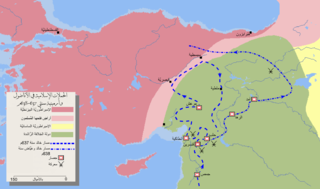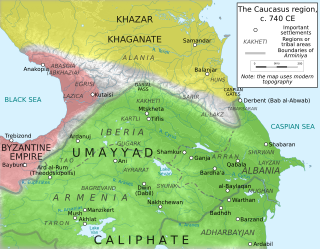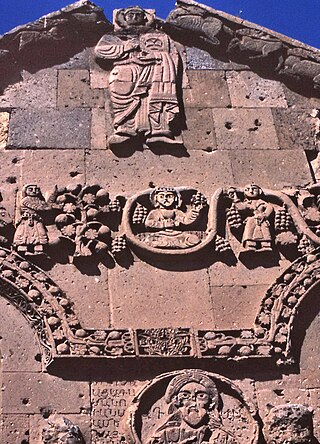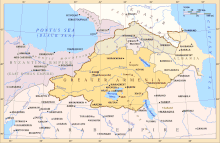
Year 775 (DCCLXXV) was a common year starting on Sunday of the Julian calendar. The denomination 775 for this year has been used since the early medieval period, when the Anno Domini calendar era became the prevalent method in Europe for naming years.
Mamikonian, or Mamikonean, was an aristocratic dynasty which dominated Armenian politics between the 4th and 8th centuries. They were the most notable noble house in Early Christian Armenia after the ruling Arsacid dynasty and held the hereditary positions of sparapet and dayeak, allowing them to play the role of kingmaker for the later Armenian kings. They ruled over extensive territories, including the Armenian regions of Tayk, Taron, Sasun, and Bagrevand, among others. The Mamikonians had a reputation as supporters of the Roman Empire in Armenia against Sasanian Iran, although they also served as viceroys under Persian rule. Their influence over Armenian affairs began to decline at the end of the 6th century and suffered a final, decisive blow after a failed rebellion against Arab rule over Armenia in 774/75.
Pahlavuni was an Armenian noble family, a branch of the Kamsarakan, that rose to prominence in the late 10th century during the last years of the Bagratuni monarchy.

The Muslim conquest of Armenia was a part of the Muslim conquests after the death of the Islamic prophet Muhammad in 632 CE. Persarmenia had fallen to the Arab Rashidun Caliphate by 645 CE. Byzantine Armenia was already conquered in 638–639.

Arminiya, also known as the Ostikanate of Arminiya or the Emirate of Armenia, was a political and geographic designation given by the Muslim Arabs to the lands of Greater Armenia, Caucasian Iberia, and Caucasian Albania, following their conquest of these regions in the 7th century. Though the caliphs initially permitted an Armenian prince to represent the province of Arminiya in exchange for tribute and the Armenians' loyalty during times of war, Caliph Abd al-Malik ibn Marwan introduced direct Arab rule of the region, headed by an ostikan with his capital in Dvin. According to the historian Stephen H. Rapp in the third edition of the Encyclopaedia of Islam:
Early Arabs followed Sāsānian, Parthian Arsacid, and ultimately Achaemenid practice by organising most of southern Caucasia into a large regional zone called Armīniya.
Ashot IV Bagratuni, better known as Ashot Msaker, reputedly for his refusal to refrain from eating meat during Lent, was an Armenian prince from the Bagratid family. A fugitive from the failed uprising in 775 against Arab rule in Armenia, where his father was killed, over the next decades he gradually expanded his domains and established a predominant role for himself in the country's affairs, becoming recognized by the Abbasid Caliphate as presiding prince of Armenia from 806 until his death in 826.

Bagratid Armenia was an independent Armenian state established by Ashot I Bagratuni of the Bagratuni dynasty in the early 880s following nearly two centuries of foreign domination of Greater Armenia under Arab Umayyad and Abbasid rule. With each of the two contemporary powers in the region—the Abbasids and Byzantines—too preoccupied to concentrate their forces in subjugating the region, and with the dissipation of several of the Armenian nakharar noble families, Ashot succeeded in asserting himself as the leading figure of a movement to dislodge the Arabs from Armenia.
Muhammad ibn Khalid ibn Yazid al-Shaybani was an Arab general and governor for the Abbasid Caliphate, active in the Caliphate's Caucasian provinces in the 9th century.
Lashkar Haytham ibn Khalid was the first Shirvanshah, or independent ruler of Shirvan, renouncing the suzerainty of the Abbasid Caliphate in 861 after Anarchy at Samarra and beginning the rule of Mazyadid or Yazidid dynasty.

Arab rule in Georgia, natively known as Araboba refers to the period in the History of Georgia when all or part of the country was under political domination of Muslim Arab rulers, from the first Arab incursions in the mid-7th century until the final defeat of the Emirate of Tbilisi at the hands of King David IV in 1122. Compared with other regions which endured Muslim conquests, Georgia's culture, and even political structure was not much affected by the Arab presence, as the people kept their faith, the nobles their fiefdoms, and the foreign rulers mostly insisted on the payment of tribute, which they could not always enforce. Still, repeated invasions and military campaigns by the Arabs devastated Georgia on many occasions, and the Caliphs retained suzerainty over large parts of the country and exerted influence over the internal power dynamics during most of the period.
Yazid ibn Mazyad al-Shaybani was an Arab general and governor who served the Abbasid Caliphate.
Khalid ibn Yazid al-Shaybani was an Arab general and governor for the Abbasid Caliphate, active in the second quarter of the 9th century.

Gagik I Artsruni was an Armenian noble of the Artsruni dynasty who ruled over Vaspurakan in southern Armenia, first as prince of northwestern Vaspurakan and after that until his death as King of Vaspurakan, also claiming the title of King of Armenia.

The Bagratuni or Bagratid dynasty was an Armenian royal dynasty which ruled the medieval Kingdom of Armenia from c. 885 until 1045. Originating as vassals of the Kingdom of Armenia of antiquity, they rose to become the most prominent Armenian noble family during the period of Arab rule in Armenia, eventually establishing their own independent kingdom. Their domain included regions of Armenia such as Shirak, Bagrevand, Kogovit, Syunik, Lori, Vaspurakan, Vanand and Taron. Many historians, such as Cyril Toumanoff, Nicholas Adontz and Ronald Suny, consider them to be the progenitors of the Georgian royal Bagrationi dynasty.
Yazid ibn Asid ibn Zafir al-Sulami or Yazid ibn Usayd ibn Zafir al-Sulami was an Arab general and governor in the service of the early Abbasid Caliphate. He was active mostly in the Caliphate's northwestern frontier region, serving as governor of Arminiya and the Jazira and fighting against the Byzantine Empire and the Khazars.
Abu Musa Isa ibn al-Shaykh ibn al-Salil al-Dhuhli al-Shaybani was an Arab leader of the Shayban tribe. Taking advantage of the domestic turmoil of the Abbasid Caliphate, he created a semi-independent bedouin state in Palestine and southern Syria in ca. 867–870, before an Abbasid army forced him to exchange his domains with the governorship of Armenia and Diyar Bakr. In Armenia, he struggled to contain the rising power of the Christian princes, but after failing to suppress the revolt of one of his own subordinates, he abandoned the country and returned to his native Jazira. There he spent his last years until his death in a struggle with a rival strongman, the ruler of Mosul Ishaq ibn Kundajiq.
Bagrat II Bagratuni was an Armenian noble of the Bagratid (Bagratuni) family and the presiding prince of Arab-ruled Armenia between 830 and 851. He succeeded his father, Ashot IV Bagratuni, as ruler of Taron in 826, and was named presiding prince by the Abbasid Caliph in 830. In 849 he began an open rebellion against Abbasid authority in Armenia. The rebellion provoked the dispatch of Bugha al-Kabir to the country, who crushed the revolt in a three-year campaign. Bagrat was treacherously captured during negotiations in 851 and brought captive to the Abbasid capital Samarra. He was succeeded in Taron by his sons, while the title of presiding prince passed to his nephew, the future King Ashot I of Armenia.
Musa ibn Zurara was the emir of Arzen, located on the borders between Upper Mesopotamia and Armenia, which at the time were provinces of the Abbasid Caliphate.
Abu'l-Maghra ibn Musa ibn Zurara was the last Zurarid emir of Arzen, located on the borders between Upper Mesopotamia and Armenia, which at the time were provinces of the Abbasid Caliphate.
Smbat VIII Bagratuni or Smbat the Confessor was an Armenian noble of the Bagratid (Bagratuni) family and one of the most important princes (nakharar) of Armenia in the mid-9th century as the commander-in-chief (sparapet) of Armenia. Taken prisoner to Samarra, he was pressured to convert to Islam but refused and died there. He was the father of Ashot I of Armenia, founder of the Bagratid Kingdom of Armenia.







